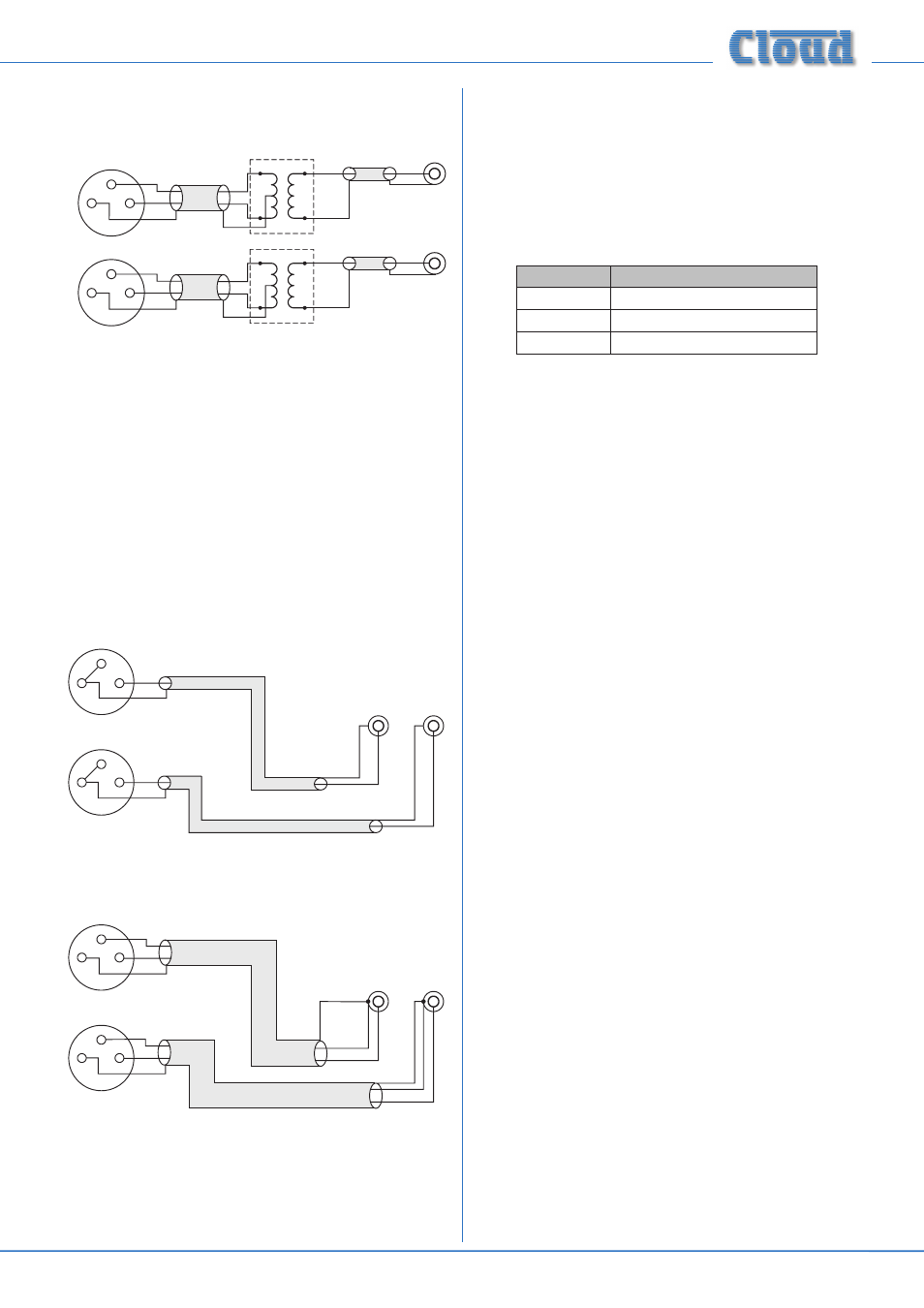Microphone input zone 1 facility port, Microphone input, Zone 1 facility port – Cloud Electronics 46-120TMedia User Manual
Page 15

46-120 Installation and User Guide V1.2
15
LEFT
+
-
SCN
Unbalanced
inputs
SCN
LEFT
+
-
SCN
Audio balancing transformers
RIGHT
+
-
SCN
Unbalanced
inputs
SCN
RIGHT
+
-
SCN
pin 1 ground
pin 2 hot
pin 3 cold
Balanced outputs (XLRs):
1
2
3
1
2
3
If transformers are not available, a balanced source may feed
an unbalanced input directly as long as care is taken over how
the connections are made. A variety of design techniques are
in use to implement balanced outputs in audio equipment,
and some designs require different wiring protocols to others.
Installers are advised to check the manuals with each item
for guidance on how the outputs should be connected to an
unbalanced input.
However, the wiring methods shown below will work in a
large number of cases. If hum or other distortion is found to
result, try disconnecting the ‘cold’ leg of the balanced output
(pin 3 on XLRs).
1
2
3
Unbalanced
inputs
LEFT
RIGHT
+
+
SCN
SCN
+
+
SCN
SCN
When using single-core cable,
join ‘cold’ to screen at the
source
LEFT
RIGHT
pin 1 ground
pin 2 hot
pin 3 cold
Balanced outputs (XLRs):
1
2
3
Unbalanced
inputs
LEFT
RIGHT
+
+
-
-
SCN
SCN
+
+
-
-
SCN
SCN
When using twin-and-screen
cable, join ‘cold’ to screen at
36-50 end
LEFT
RIGHT
pin 1 ground
pin 2 hot
pin 3 cold
Balanced outputs (XLRs):
1
2
3
1
2
3
Microphone input
Inputs
MIC 1/TEL and MIC 2 are intended for the direct
connection of microphones. They are electronically balanced
and transformerless with an input impedance of greater than
2 kohms and optimised for use with microphones of 200 to
600 ohms impedance. The screw terminal input connectors
should be wired thus:
PIN
CONNECTION
1
Screen
2
Signal ‘-‘ (cold)
3
Signal ‘+’ (hot)
Unbalanced microphones may be used by connecting pin 2
to pin 1 (cable screen) in the mating (male) screw-terminal
connector. 15 V phantom power is available, see page 22.
Either mic input may be routed to any of the zones in use,
at any level in each zone. Microphone priority may be set
so that any microphone announcements automatically reduce
the music level in that zone while the announcement is in
progress (see page 24 for more details.)
The
MIC 1/TEL input may be reconfigured to accept an
audio input directly from a compatible telephone system.
This permits announcements to be made from some (or any)
internal telephone extensions in a building. Not all telephone
systems are suitable for this application, and the system
documentation should be consulted in detail to ensure
compatibility.
Internal jumpers J17A, J17B and J17C need to be moved
for this application. See page 30 for further information
regarding the internal jumpers. This inserts a transformer
in series with the input connector to provide full electrical
isolation from the telephone system. Note that the mic input
sensitivity is decreased by 10 dB when the transformer is
enabled, and this results in the mic gain control operating
over the range 0 dB to 40 dB.
The audio (or “paging”) output of the phone system should
be connected to the
MIC 1/TEL input in the normal way.
The telephone input is optimised for connection to an output
of 600 ohms impedance; this should suit the majority of
telephone systems. Note that the front panel
MIC 1 LEVEL
controls ([3] on page 11) are still operational.
Zone 1 Facility Port
Zone 1 of the mixer amplifier is provided with a
FACILITY
PORT in the form of a rear panel 8-way RJ45 connector.
The primary use of the Facility Port is for the connection
of an LM-2 remote active module, but it may also be used
as a general-purpose auxiliary balanced input (see page 26
for more information on this application). Note that audio
connected via the
FACILITY PORT will only be available in
Zone 1, and no other.
The active modules operate from DC power supplied by the
46-120. The current consumed by each module is minimal and